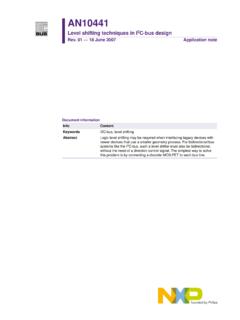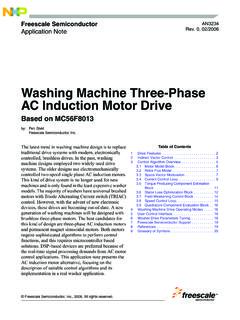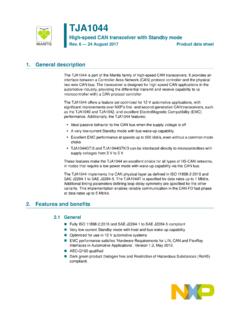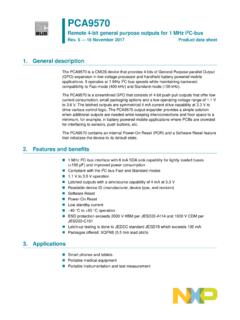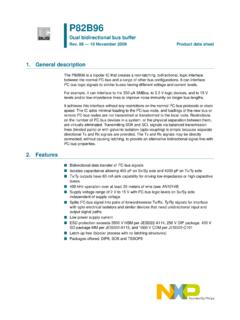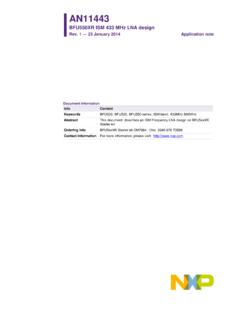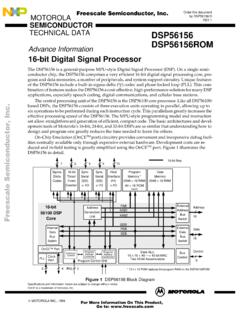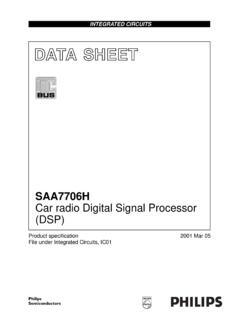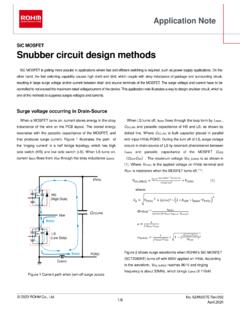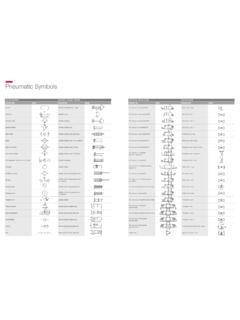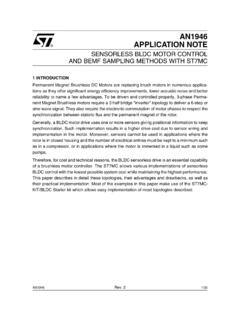Transcription of High-speed CAN transceiver - NXP
1 1. General descriptionThe TJA1043 High-speed CAN transceiver provides an interface between a Controller Area Network (CAN) protocol controller and the physical two-wire CAN bus. The transceiver is designed for High-speed CAN applications in the automotive industry, providing differential transmit and receive capability to (a microcontroller with) a CAN protocol TJA1043 belongs to the third generation of High-speed CAN transceivers from NXP Semiconductors, offering significant improvements over first- and second-generation devices such as the TJA1041A. It offers improved ElectroMagnetic Compatibility (EMC) and ElectroStatic Discharge (ESD) performance, very low power consumption, and passive behavior when the supply voltage is turned off.
2 Advanced features include: Low-power management controls the power supply throughout the node while supporting local and remote wake-up with wake-up source recognition Several protection and diagnostic functions including bus line short-circuit detection and battery connection detection Can be interfaced directly to microcontrollers with supply voltages from 3 V to 5 VThe TJA1043 implements the CAN physical layer as defined in ISO 11898-2:2016 and SAE J2284-1 to SAE J2284-5. This implementation enables reliable communication in the CAN FD fast phase at data rates up to 5 features make the TJA1043 the ideal choice for high speed CAN networks containing nodes that need to be available all times, even when the internal VIO and VCC supplies are switched Features and General ISO 11898-2.
3 2016 and SAE J2284-1 to SAE J2284-5 compliant Loop delay symmetry timing enables reliable communication at data rates up to 5 Mbit/s in the CAN FD fast phase Suitable for 12 V and 24 V systems Low ElectroMagnetic Emission (EME) and high ElectroMagnetic Immunity (EMI) VIO input allows for direct interfacing with 3 V and 5 V microcontrollers SPLIT voltage output for stabilizing the recessive bus level Listen-only mode for node diagnosis and failure containment Available in SO14 and HVSON14 packagesTJA1043 High-speed CAN transceiverRev. 6 10 November 2017 Product data sheetTJA1043 All information provided in this document is subject to legal disclaimers. NXP Semiconductors 2017. All rights data sheetRev. 6 10 November 2017 2 of 32 NXP SemiconductorsTJA1043 High-speed CAN transceiver Leadless HVSON14 package ( mm mm) with improved Automated Optical Inspection (AOI) capability AEC-Q100 qualified Dark green product (halogen free and Restriction of Hazardous Substances (RoHS) compliant) Low-power management Very low current Standby and Sleep modes, with local and remote wake-up Capability to power down the entire node while supporting local, remote and host wake-up Wake-up source recognition transceiver disengages from the bus (zero load) when VBAT absent Functional behavior predictable under all supply Protection and diagnosis (detection and signalling)
4 high ESD handling capability on the bus pins Bus pins and VBAT protected against transients in automotive environments Transmit Data (TXD) dominant time-out function with diagnosis TXD-to-RXD short-circuit handler with diagnosis Thermal protection with diagnosis Undervoltage detection and recovery on pins VCC, VIO and VBAT Bus line short-circuit diagnosis Bus dominant clamping diagnosis Cold start diagnosis (first battery connection)3. Quick reference data Table reference dataSymbolParameterConditionsMinTypMaxUn itVCCsupply voltage on pin (VCC)undervoltage detection voltage on pin (VIO)undervoltage detection voltage on pin VIOVBATor VCC > currentNormal mode; bus dominant304865mANormal or Listen-only mode; bus recessive369mAStandby or Sleep 2 AIIO supply current on pin VION ormal mode; VTXD= 0 V (dominant)-150 500 ANormal or Listen-only mode; VTXD=VIO (recessive)014 AStandby or Sleep mode014 AVESD electrostatic discharge voltageIEC 61000-4-2 at pins CANH and CANL 8- +8 kVTJA1043 All information provided in this document is subject to legal disclaimers.
5 NXP Semiconductors 2017. All rights data sheetRev. 6 10 November 2017 3 of 32 NXP SemiconductorsTJA1043 High-speed CAN transceiver4. Ordering information VCANH voltage on pin CANH 58-+58 VVCANL voltage on pin CANL 58-+58 VTvjvirtual junction temperature 40-+150 CTable reference data ..continuedSymbolParameterConditionsMinT ypMaxUnitTable informationType numberPackageNameDescriptionVersionTJA10 43 TSO14plastic small outline package; 14 leads; body width mmSOT108-1 TJA1043 TKHVSON14 plastic, thermal enhanced very thin small outline package; no leads; 14 terminals; body 3 mmSOT1086-2 TJA1043 All information provided in this document is subject to legal disclaimers. NXP Semiconductors 2017. All rights data sheetRev.
6 6 10 November 2017 4 of 32 NXP SemiconductorsTJA1043 High-speed CAN transceiver5. Block diagram Fig diagram7(03(5$785( 3527(&7,217,0( 28702'( &21752/ :$.( 83 &21752/ (5525 '(7( '5,9(57;' 9,2 5;' 6/23( &21752/ '5,9(59&&&$1+&$1/ *1'7-$ 63/,763/,7 :$.( 83 ),/7(5 DDD 9&&9,29%$7 67%B1 (1(55B1 9%$7 :$.(9%$7,1+ TJA1043 All information provided in this document is subject to legal disclaimers. NXP Semiconductors 2017. All rights data sheetRev. 6 10 November 2017 5 of 32 NXP SemiconductorsTJA1043 High-speed CAN transceiver6. Pinning Pinning Pin description [1]HVSON14 package die supply ground is connected to both the GND pin and the exposed center pad. The GND pin must be soldered to board ground. For enhanced thermal and electrical performance, it is recommended that the exposed center pad also be soldered to board Functional descriptionThe TJA1043 is a stand-alone High-speed CAN transceiver with a number of operating modes, fail-safe features and diagnostic features that offer enhanced system reliability and advanced power management.)))))))))))))))))
7 The transceiver combines the functionality of the Fig configuration diagram: SO14 Fig configuration diagram: HVSON147-$ 77;'67%B1*1'&$1+9 '63/,79,29%$7(1:$.(,1+(55B1 DDD WHUPLQDO LQGH[ DUHD7-$ ;' *1' 5;' 9,2 (1 ,1+ 67%B1 &$1+ &$1/ 63/,7 9%$7 :$.( (55B1 9&& DDD Table descriptionSymbolPinDescriptionTXD1trans mit data inputGND[1]2ground supplyVCC3transceiver supply voltageRXD4receive data output; reads out data from the bus linesVIO5supply voltage for I/O level adaptorEN6enable control inputINH7inhibit output for switching external voltage regulatorsERR_N8error and power-on indication output (active LOW)WAKE9local wake-up inputVBAT10battery supply voltageSPLIT11common-mode stabilization outputCANL12 LOW-level CAN bus lineCANH13 high -level CAN bus lineSTB_N14standby control input (active LOW)TJA1043 All information provided in this document is subject to legal disclaimers.))))))]
8 NXP Semiconductors 2017. All rights data sheetRev. 6 10 November 2017 6 of 32 NXP SemiconductorsTJA1043 High-speed CAN transceiverTJA1041A with improved EMC and ESD capability and quiescent current performance. Improved slope control and high DC handling capability on the bus pins provide additional application Operating modesThe TJA1043 supports five operating modes. Control pins STB_N and EN are used to select the operating mode. Switching between modes allows access to a number of diagnostics flags via pin ERR_N. Ta b l e 4 describes how to switch between modes. Figure 4 illustrates the mode transitions when VCC, VIO and VBAT are valid. [1]Setting the UVNOM flag will clear the WAKE flag.[2]Setting the Wake flag will clear the UVNOM flag.
9 [3]A LOW-to- high transition on pin STB_N will clear the UVNOM flag[4]After the minimum hold time, in Go-to-Sleep mode, th(min), the transceiver will enter Sleep mode and pin INH will be set mode selectionInternal flagsControl pinsOperating modePin INHUVNOM[1]UVBATWake[2]STB_N[3]ENFrom Normal, Listen-only, Standby and Go-to-Sleep modessetXXXXS leep modefloatingclearedsetXHIGHXS tandby modeHIGH clearedXsetLOWXS tandby modeHIGH clearedXclearedLOWLOWS tandby modeHIGH clearedXclearedLOWHIGHGo-to-Sleep mode[4] high [4]clearedclearedXHIGHLOWL isten-only modeHIGH clearedclearedXHIGHHIGHN ormal modeHIGHFrom Sleep modesetXXXXS leep modefloatingclearedsetXHIGHXS tandby modeHIGH clearedXsetLOWXS tandby modeHIGH clearedXclearedLOWXS leep modefloatingclearedclearedXHIGHLOWL isten-only modeHIGH clearedclearedXHIGHHIGHN ormal modeHIGHTJA1043 All information provided in this document is subject to legal disclaimers.
10 NXP Semiconductors 2017. All rights data sheetRev. 6 10 November 2017 7 of 32 NXP SemiconductorsTJA1043 High-speed CAN transceiver Normal modeIn Normal mode, the transceiver can transmit and receive data via the bus lines CANH and CANL (see Figure 1 for the block diagram). The differential receiver converts the analog data on the bus lines into digital data which is output to pin RXD. The slopes of the output signals on the bus lines are controlled internally and are optimized in a way that guarantees the lowest possible EME. The bus pins are biased to (via Ri). Pin INH is active, so voltage regulators controlled by pin INH (see Figure 9) will be active Listen-only modeIn Listen-only mode, the transceiver s transmitter is disabled, effectively providing a transceiver listen-only feature.
